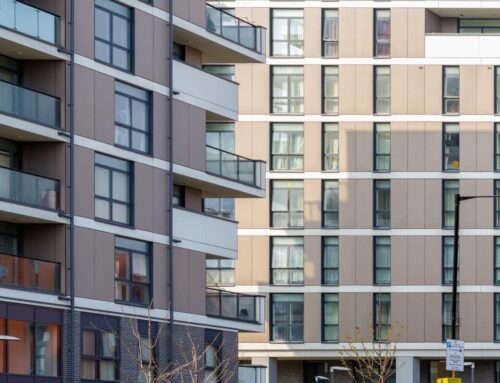Belinda Bagnall, Managing Director at Residentsline, provides an update on building safety, particularly focusing on the Building Safety Act.
With so many changes to leasehold law in recent years, we wanted to provide a succinct round up of the current pipeline for 2024 and beyond. The stricter regulations laid out in the Building Safety Act are focussed on enhanced fire safety, the regulation of building materials and inspection protocols.

Builder inspection consultancy. Inspector checking material and structure in construction.
Today we will be covering what the Act means for Principal Accountable Persons of high-rise residential blocks, including a timeline of notable dates.
Building Safety Act Background
The Building Safety Act is the result of Government investigations into unsafe cladding and necessary remedial works for high-rise dwellings in the UK. It has come about in response to the Grenfell tragedy and other high-profile incidents in high-rise blocks.
The aim of the Act is to reduce the likelihood and the severity of incidents, with a focus on fire safety and structural failure: “It delivers far-reaching protections for qualifying leaseholders from the costs associated with remediating historical building safety defects, and an ambitious toolkit of measures that will allow those responsible for building safety defects to be held to account.” UK Government
A New World of Responsibilities
The Act impresses many new responsibilities on building managers and a Principal Accountable Person (PAP) must now be appointed to ensure the new requirements are properly implemented.
The PAP can be an individual (such as a freeholder or property manager), or it can be a business that work with you to fulfil the requirements:
Enhanced Fire Safety Standards
This includes the requirement for safer cladding materials and improved fire resistance of building components. New regulations also stipulate the installation of fire suppression systems such as sprinklers in high-rise residential buildings. It is made clear in the requirements that financial responsibility for any remedial works will fall to the property owner.
Stricter Regulations for Building Materials
Stricter control over building materials is a key element of the Act. Only materials that meet the highest safety standards are now approved for use. This ensures that all components used in construction are reliable and durable, reducing the risk of structural failures. The Act stipulates structural surveys, safety risk assessments and remediation work where needed.
Improved Inspection Protocols
Regular inspections are now mandatory, ensuring ongoing compliance with safety standards. These inspections cover all aspects of building safety from structural integrity to fire safety measures.
Further responsibilities for the Accountable Person include:
- Registering all new and existing buildings covered by the act with the Building Safety Regulator
- Conducting regular building safety assessments and maintaining safety case reports
- Preparing a resident engagement strategy
- Developing a framework and process to ensure the reporting of mandatory and voluntary occurrences to the Building Safety Regulator
- Applying for and display a Building Assessment Certificate
Enforcement
A new section of the Health and Safety Executive (HSE) has been created to oversee the implementation of the Act’s requirements. They are called the Building Safety Regulator. They can act if property managers are not meeting their responsibilities.
Their options for redress include:
- Providing verbal and written warnings
- Requiring improvements in the way risks are controlled and managed
- Requiring action to be taken to remedy non-compliance
- Stopping certain activities where they create serious risks or where they do not comply with relevant requirements
- Recommending and bringing prosecutions where there has been a serious breach of law
- Seeking appointment of special measures managers when an appointed person for a higher-risk building fails to carry out building safety functions
Timeline of Deadlines for Changes
The past deadlines and timeline for the implementation of future changes is as follows:
- April 2022: Introduction of the Building Safety Act
- October 2022: Initial compliance checks for high-rise residential buildings
- January 2023: Deadline for the installation of fire suppression systems in new high-rise constructions
- July 2023: Regular mandatory inspections for existing buildings commenced
- October 2023: PAP must register high risk buildings with the BSR
- December 2023: Full compliance required for all residential buildings, including the use of approved building materials and completion of safety inspections.
- February 2024: Online portal goes live for managers to see if their high-rise is registered
- April 2024: Building Safety Cases and Safety Case Reports to be complete and the BSR to start their assessments before issuing Building Assessment Certificates
- June 2024: Final deadline for all buildings to adhere to the new regulations, with penalties enforced for non-compliance
The introduction of the Building Safety Act 2022 represents a significant advancement for building safety in the UK. By enhancing fire safety standards, enforcing stricter regulations for building materials and improving inspection protocols, the Act aims to protect the safety and well-being of building occupants.
Residentsline has been providing insurance for flats and apartments for over 25 years. We enjoy providing support and assistance to our customers in all areas of leasehold. Call us today for a quote at 0800 281 235.




Leave A Comment